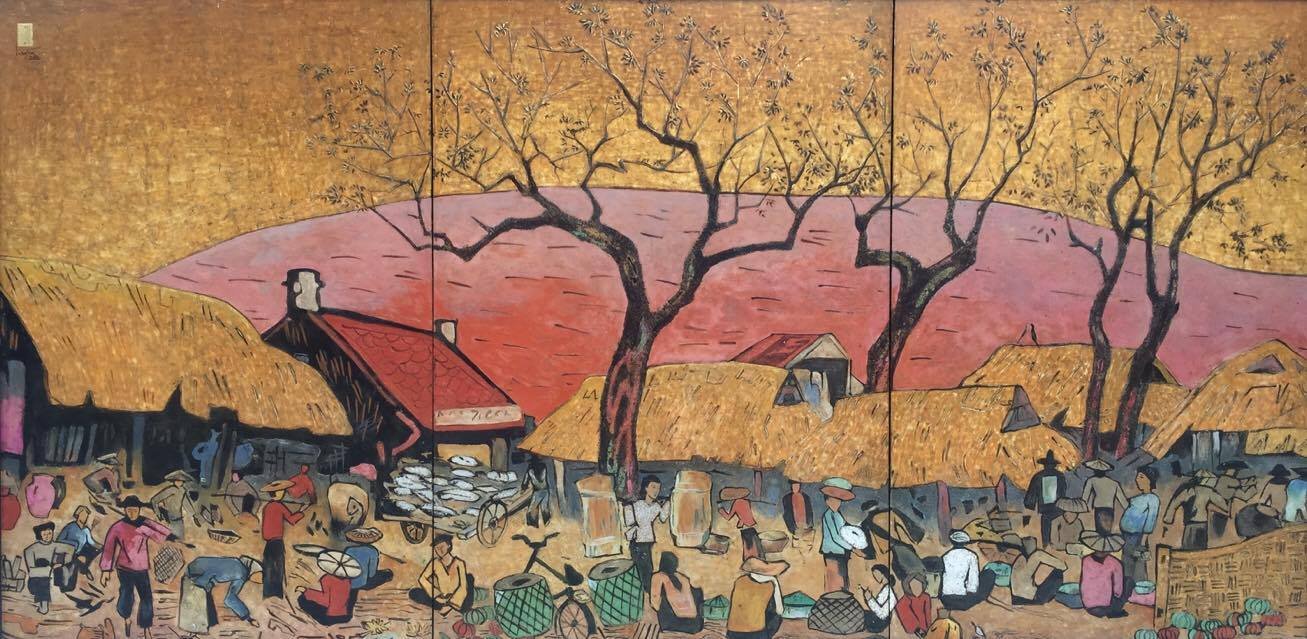
Vu Duy Nghia
Biography
Master artist Vu Duy Nghia (1935-2022) has become one of the notable Vietnamese artists who blends local art with movements from the Soviet era. Since the end of the Cold War, while art historians around the world have been reassessing the legacy of Socialist Realism in Eastern Bloc countries, the contributions of Vietnamese artists who spent time in the Soviet Union from the 1960s to the 1980s have been somewhat overlooked.
Within Vietnam, historical texts recognize the great influence that the Ecole des Beaux-Arts de l’Indochine has had on the first generation of Vietnamese modern painters, but there is little discussion of the impact of a Soviet education on a group of Vietnamese painters during the period following independence and reunification.
This tribute to Vu Duy Nghia is an eye-opener for anyone who might think that the so-called Soviet era did not produce great art. Beginning with his paper cuts, through to his lacquer paintings and works on paper, Nghia was a prolific artist whose work cannot be reduced to one style or movement.
Traces of Soviet and European realism can be found in his prints of factory workers and farmers, but mostly his oeuvre is poetic, expressive, beautiful, and complex. His work is also deeply patriotic and direct.
Professor Nora A. Taylor from the School of the Art Institute of Chicago said, "It is rare to find artists with his skills in paper cutting. This art form requires the ability to envision in both an abstract and a realistic manner, to see both light and dark simultaneously, and outline and content together."
"Through this medium, he created some dramatic landscapes with large black shapes that accentuate the darkness of the sky, for example, the sharp thorns of a cactus, or the wrinkles of an elder’s face. He translated some of these same images into colorful prints, gouaches, and lacquers, but with color, the theatricality turned to poetry. The same boats became light floating vessels, and the cactus turned into a flower," he added.
His talent for line emerges, especially in the prints that he made during the war. The bodies of soldiers and laborers appear strong and tenacious. In the post-Doi Moi era, art historians have been understandably focused on the future of Vietnamese contemporary art and the new generation of artists. But, it is important to recognize the talent and contributions of Nghia’s generation to the development of modern and contemporary art history. Nghia, and others who studied in Socialist bloc countries, did so out of necessity, patriotism, and a desire to learn.
During the Cold War, there were few opportunities for artists in Vietnam to travel outside the Soviet Bloc. These stays infused Vietnamese art with a cosmopolitan flavor that strengthened the artists' ongoing commitment to modernism.
"Nghia is an example of how looking outward towards international art movements enhanced Vietnamese art rather than diminished it. The vivid, expressive faces on the figures in Nghia’s portraits might remind one of Soviet portraits, but under Nghia’s touch, they are undeniably Vietnamese," Taylor noted.
1935: Born in Bat Trang, Gia Lam, Hanoi.
1950-1954: Learning from mail exchanges with painter Manh Quynh.
1955-1957: Attending Vietnam University of Fine Arts (formerly Hanoi College of Fine Arts, ‘Tô Ngọc Vân Memorial Class’).
1958-1965: Attending Moscow State Stroganov Academy of Design and Applied Arts, Russia. During this period, he returned to Vietnam for one year to attend compulsory “correctional training”. As revisionism policies emerged in the Soviet Union (1963-1964), all Vietnamese art students studying abroad were summoned back home by the Ministry of Culture in order to reinforce the Party’s tenet and prevent negative repercussions of Revisionist policies before resuming their studies.
1967-1995: Serving as lecturer at the Faculty of Graphic Art, Vietnam University of Industrial Fine Arts (formerly Vietnam College of Industrial Fine Arts); becoming a member of Vietnam Fine Arts Association (VFAA) in 1968 with a specialization in graphic art.
1983-1989: Serving as a member of the Central Art Council of the Vietnam Fine Art Association 2nd term, President of Graphic Art.
1989-1994: Member of the Central Art Council of the Vietnam Fine Art Association 3rd term.
1994-1999: Member of the Central Art Council of the Vietnam Fine Art Association 4th term.
1990-2020: Exploring and experimenting with lacquer. Artworks are epic, monumental and poetic.
Awards
- Third class medal in honor of the Resistance against the US.
- Medal of Contributions for the Development of Vietnamese Literature and Arts;
- Medal of Contributions for the Cause of the Fine Arts in Vietnam;
- Medal of Contributions for the Young Generation of Vietnam;
- Silver Medal, 1980 National Fine Art Exhibition, 1980;
- Gold Medal, National Fine Arts Exhibition, 1990;
- Encouragement Prize, Fine Arts Exhibition on the Armed Forces and Revolutionary War;
- National Prize in Literature and Arts, 2001, for the following artworks:
“Thatched hut at the foot of the mountain” (1985), woodcut, 70x80cm;
“Light in a bottle” (1990), lacquer, 90x120cm;
“Morning in Hạ Long” (1993), colored woodcut, 70x70cm;
“Harvest season” (1993), lacquer, 90x90cm;
“That autumn” (1996), lacquer, 80x105cm;
“Farewell bygones” (1998), woodcut, 75x52cm.
Notable Works
“Rice threshing” (1972), woodcut, in the collection of Vietnam National Museum of Fine Arts;
“Wood chopping” (1974), woodcut, in the collection of Vietnam National Museum of Fine Arts;
“Old lady crushing betel nuts” (1977), papercutting, in the collection of Vietnam National Museum of Fine Arts.
“Bottle lamp” (1990), lacquer, Gold Medal, National Fine Art Exhibition;
“That autumn” (1996), lacquer, in the collection of Vietnam National Museum of Fine Arts.






Vu Duy Nghia
Lacquer on wood
120 x 80 cm
SOLD